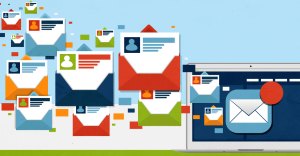5 Steps to Build Amazing Email Lists from the Ground Up



The most widely adopted Internet social network isn’t Facebook, Twitter, or LinkedIn: It’s email. More than 85 per cent of adults who are online have an email account while 62 per cent have a social networking account. And those email users are far more engaged than even Facebook users: Only one
The most widely adopted Internet social network isn’t Facebook, Twitter, or LinkedIn: It’s email.
More than 85 per cent of adults who are online have an email account while 62 per cent have a social networking account. And those email users are far more engaged than even Facebook users: Only one Facebook status update is posted for every 83 emails sent. Email performs better than social media when it comes to content visibility and interaction. Average email open rates can hover around 30 per cent, depending on the industry.
While it’s important to continue to grow your community and help your customers through social media, don’t forget to nurture email, the most lucrative and engaging sales channel. Let’s talk about the lifeblood of your email program: building email lists.
Getting your first 100 (or 10,000) email subscribers
When it comes to growing your email list, if it’s too good to be true, it probably is—especially if you don’t want to violate anti-spam legislation. There’s no overnight solution or quick fix. However, if done right, those first email subscribers will be highly engaged and eager to hear from you.
1. Focus on building lists, not buying them.
Email is an excellent medium at any stage of the customer lifecycle except the beginning when the customer has never even heard of your company. Many first-time email marketers skip straight to buying lists. The email contacts in those lists are likely unfamiliar with the product, which means there’s a good chance they will report incoming emails as spam.
Being reported for spam is not the only problem with purchasing or scraping lists. Email services, such as MailChimp, Salesforce Marketing Cloud, and Constant Contact, can and will shut down email accounts if a company exceeds one spam complaint per 1,000 emails sent or more. If caught by the government, businesses could be fined up to $10 million. Plus, the brand could suffer from negative sentiment associated with unsolicited emails.
Every email marketer should strive to keep emails as relevant as possible. It starts at the beginning: Plan to build your email list with an eye on relevancy and retention. Ensure only those who want to hear from you are on the list. That means staying away from any source where the contact did not give you explicit permission to email them.
2. Know the list’s purpose.
Before you set out to collect subscribers, define why you’re doing it. Lay out a purpose for the list to assist every step going forward.
- Who will be on the list? At what point are they in the customer lifecycle?
- What business goals will this list address? Will it help in:
- Creating brand awareness?
- Building trust?
- Driving traffic to the website?
- What will be mailed to this segment to accomplish the goals?
- Educational content?
- News?
- Discounts?
If you have multiple business goals or target audiences, consider creating multiple email lists. It’s easier to segment them at their current stage of the customer lifecycle than build one large list and then segment.
3. Keep the data clean from the start.
The earlier you implement data requirements, the easier it will be for you and your lists. Know what data you need before asking for opt-ins. Adding additional opt-in form fields added after you begin collecting can result in fragmented records at best, and leave you scrambling for important data in the future.
Need a place to start to know the type of data you should collect?
- Email address is essential. If your email service provider does not include a qualifier to ensure a properly formatted email address, look into setting up rules to validate the email address. (For example, an email address must contain an @domain.)
- Opt-in records proving the contact gave explicit permission to add them to your list. This is often tracked in most email service provider software. If you have an offline print form, consider including a check box that says, “Yes, I would like to receive emails from [company].” Canada’s Anti-Spam Legislation requires senders to prove they received permission to send email to an individual should they be audited.
Remember to keep an accurate account of where the contact opted in as well. Many email marketing software platforms include a note in the footer of emails stating why that contact is receiving the email. (For example, “Signed up on our website.”) This provides context and helps prevent frustrated recipients from reporting spam.
- The subscriber’s name if you plan on including personalization. An example of a personalized email is one that includes a coded field in the greeting where the first name will be automatically included (For example, “Hello John!”)
A word of caution on personalization: Auto-greetings have a way of going awry from time to time. Either the data is not pulled and substituted correctly or the subscriber mistyped their name (amongst other things). This mistake lifts the veil of personalization and immersion is lost. Sometimes an exceptional error will be mocked on Twitter. However, personalization can pack a punch for humour.
Remember that the subscriber will provide most of the data you’re collecting for a contact during the opt-in process. Maximize your conversion rate (the number of subscribers) by making it as simple as possible for them to subscribe. That may mean fewer input fields on the form, as many potential subscribers do not want to take the time to fill out more than a few fields.
Really want those subscribers? Consider simply asking for their email address and nothing more.
4. Place the subscribe form where your customers are.
Time to put on your marketing hat. Get creative about how to draw in your first subscribers.
There are two logistical hurdles to overcome in order to obtain subscribers: ask, and make the opt-in process obvious. Many organizations lose out at the “ask” part because they don’t do it. Most contacts will not go out of their way to learn if you have an email newsletter they can sign up for. (More on that in the next section.)
Here, let’s address making the opt-in process obvious. Knowing where your customers are and creating a simple opt-in process simple is key to more signups. Make it clear and obvious in order to reap the rewards.
Website Opt-in Forms
Form simplicity and appearance
The simpler the form, the better. One field asking for an email address will receive more signups than the same form with two fields: name and email address.
Consider A/B testing your opt-in form. Test variables such as images (human faces, cartoons, objects), text, and button color. Many websites have reported the best results came with green buttons. However, it’s best to test what color works well for your website and audience.
Simplicity Trumps all for Website Opt-in Forms
The simpler the form, the better
- One field asking for an email address will receive more signups than the same form with two fields: name and email address
- A/B test your opt in form
- Test variables such as:
- Images
- Text
- Button color

Placement
Consider form placement for maximum visibility. Most website heat maps (which demonstrate where eyes move around a website) have shown that eyes give preference to content that’s closest to the top left corner of a page. Opt-in forms close to the top left will most certainly be spotted, but may interfere with website branding and navigation.
An alternative is to place a bar along the top of a page with a link to the opt-in form, such as the HelloBar. Another high-visibility placement is a permanent field for an email address in the top right corner—away from navigation and branding, but difficult to miss.
Check your website analytics for key areas of engagement. For example, is the blog your most popular page? Is it getting many visits with long page-view times? Consider adding a subscription field halfway through or at the bottom of every blog post. If your audience has reached the bottom of a post, they may be more trusting of the information you’re sharing with them and may be more likely to subscribe.
Pop-up Forms
And then there are the controversial pop-up forms. Some feel these shadowbox forms that float over site content are a bad user experience, a large and aggressive obstruction that may reflect poorly on the brand.
However, the data doesn’t lie. Many sources that use pop-ups tout their effectiveness. (Conversely, those who have tested removing pop-ups saw a sharp decrease in subscription rates.) Some even reported pop-ups converting at 300 per cent.
The not-so-great news about pop-ups: Though they can significantly boost signups, those who subscribe through a popup are less engaged than those who subscribe through a static website form. That means fewer opens and click-throughs.
Social Media
Increasingly across major social media channels—including Facebook, Twitter, LinkedIn and Pinterest—companies have to pay to get their message in front of the right audience. As organic reach dwindles, companies are faced with the decision to supplement their social media campaigns with paid advertising or accept a declining reach.
It doesn’t hurt to remind your social media followers (multiple times) that you have a fantastic email newsletter. Twitter even offers Lead Generation Cards through their advertising platform. A tweet is appended with a small pre-populated form based on the subscribing user’s Twitter account information. With a click of a button the form can be sent to your opt-in list. And some email services provide a form template that is specifically imported to a Facebook page, making it easy for fans to subscribe.
Brick-and-Mortar Store
A physical location that’s visited by customers is the perfect time to ask for an opt-in. Provide a brief form explaining what customers can expect from your email program. Be sure to make it clear that providing an email address will opt them into email updates. Retain a copy of all completed forms as this is your proof of opt-in.
Place the simple form near cash registers and other places customers wait frequently. During a transaction, ask the customer if they would like to subscribe (ask for their email address and verbal allowance to opt in).
Other sources
This doesn’t mean scraping or buying email lists from third parties. Think of other places your fans may be that aren’t near an opt-in form.
For example, fans who have attended multiple events hosted by your company may be more likely to subscribe to your email list than someone who has just walked through the door for the first time. Let your event-attending audience know they can learn more and receive updates by opting in.
How about active and vocal members of your community? Reach out to them one-on-one and share the link to subscribe for more information. (The most active community members will be more likely to share email content as well.)
Do you have a partner blog with more readers than yours? Navigate a shout-out for your email newsletter to generate awareness.
5. Sell customers on subscribing.
Now that you know where you’re placing your opt-in form, plan to ask for coveted email addresses. “Hear more from us” or “learn more about us,” isn’t compelling.
Think like a salesperson. What’s in it for the subscriber? How is this email going to stand out in their inbox? What makes them look forward to it? Why are they visiting your website? What do they need to resolve?
Reasons People Subscribe to Email Lists
- Exclusivity. They’re receiving an inside look at something no one can see anywhere else. The email includes information that puts them on the “inside.”
- Convenience. Their lives are made easier by having information delivered to their inbox. Perhaps they want to be notified when a sale comes around or a new shipment arrives in the store.
- Freebies. They signed up in exchange for something free—perhaps a giveaway at a fair booth, a free e-book online, or a random reward for subscribers.

Email continues to be a valuable channel for connecting with your audience. Email engagement, including click-through rates, can be higher than on social networks. An audience subscribes to an email list because they want to hear from that company. An email doesn’t compete for screen space with other content as it does with social networks.
So, what are you doing to grow your email list?
5 Steps to Grow Email Lists Built to Last
- Focus on building lists, not buying them
- Build your email list with an eye on relevancy and retention
- Ensure only those who want to hear from you are on the list
- Avoid any source where the contact did not give you explicit permission to email them
- Know the list’s purpose
- Before you set out to collect subscribers, define why you’re doing it
- If you have multiple business goals or target audiences, consider creating multiple email lists
- Keep the data clean from the start
- Know what data you need before asking for opt-ins
- For starters, obtain:
- Email address
- Opt-in records
- The subscriber’s name
- Place the subscribe form where your customers are
- Know where your customers are
- Create a simple opt-in process
- Consider form placement for maximum visibility
- Sell customers on subscribing
- Plan a strategy to ask for that coveted email address
- “Hear more from us” or “learn more about us,” isn’t compelling
- What’s in it for the subscriber? How is this email going to stand out in their inbox?
Share ‘5 Steps to Build Amazing Email Lists from the Ground Up’ On Your Site

About the Author:
Lauren Hall-Stigerts is the owner of Marketing Gal Consulting, a content marketing and social media agency in Seattle. She helps software and digital gaming companies get seen, build trust, and grow their audience. Lauren is also an active musician, gamer, and tea enthusiast. Follow her on Twitter @hallstigerts.
























